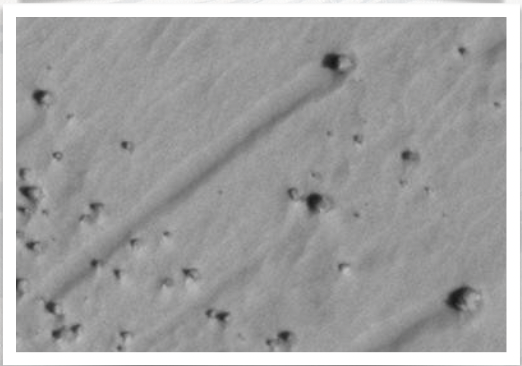Research
in planetary sciences
Effects of subsurface water/ice on spatial distributions of ejecta
Ejecta blankets around craters on a km-scale show stark differences in the "scaled ejecta radius" (maximal extent of ejecta divided by the crater radius) with latitude and types of plains on Mars, which has been known for a long time but is not well-understood. The main goal of this work is to explore the idea that the subsurface rheology drives ejecta dynamics and leaves characteristic, observable imprints in the spatial distributions of ejecta. In order to test this, I used numerical simulations of impact cratering into a variety of subsurface models, which include variations in the depth of water or ice covering basalt; the thickness of buried ice; and the depth of burial of ice. As it turns out, ejecta blankets around km-scale craters are sensitive to subsurface rheology and these spatial differences can be resolved by spacecraft imaging systems. See the article in Icarus.
The meaning of ejecta mobility based on small strength-dominated craters on Mars
Much like crater size and morphology, the dynamics of ejecta can be sensitive to the target properties. Recent work on ejecta spatial distributions of km-sized craters has shown that subsurface rheology modifies the maximum extent of the ejecta blanket, even without invoking ground-hugging. This effect should be stronger in strength-dominated craters such as those newly found on Mars. I compiled geologically-motivated subsurface models based on extensive literature review of data gathered by orbiters and landers. This work scrutinizes 1) the effects of varying properties of materials in single layer targets; 2) the impact of the presence of regolith of varied thickness; and 3) the sensitivity of ejecta dynamics to complex layering. The results show promise for using numerical simulations in concert with observations to study the shallow subsurface of Mars. Premilinary results are shown in the LPSC abstract, and the paper is under review. Image credit: NASA/JPL-Caltech/Univ. of Arizona.
Rockfalls on Mars
Rockfalls (also known as boulder falls) are one of the most understudied mass wasting processes on Mars. These fast and massive boulders are not only efficiently eroding planetary surfaces but also posing threats for in-situ instrumentation. What drives or triggers them? Where can they be commonly found? When did they form? And what do they reveal about the subsurface? These and many other questions are currently addressed by me and my colleagues, as well as a group of undergraduates at Brown. Some of our first results can be found in the following abstracts: [1] Sokolowska et al. , [2] Daubar, Sokolowska et al. , [3] Bonab et al. . Image credit: NASA/JPL-Caltech/Univ. of Arizona.
in computational astrophysics
Hot coronae around galaxies
As one of the key predictions of hierarchical structure formation models, the Milky Way-like galaxies are expected to be embedded in hot and diffuse cocoons of gas. These cocoons are thought to be generated outside-in purely by the gravitational compression of gas, not inside-out by the energy injections from exploding stars. I performed and analysed high-resolution simulations of the Milky Way-like galaxies forming in the cosmological framework and predicted the presence of significant hot gas in the halos well before the halos ought to be able to sustain hot mode accretion in the conventional picture. My work provided theoretical foundations for the existance of a previously unknown stage of the coronal formation driven by merger-induced shock heating and supernovae feedback.
Galaxy-Halo connection
In the standard theory of disk galaxy formation the sizes of galaxies an be easily explained if baryons retain their specific angular momentum, initially resulting from tidal torques, as they collapse into the halo centers. One of the major advancements in the systematics of the "galactic zoo" was linking morphologies with stellar angular momentum per unit mass (relationship known as j-M diagram). In this project, high-resolution zoom-in cosmological simulations of late-type galaxies provided a laboratory for studying the evolutionary tracks of gas and stars on the j-M* diagram, as well as the coupling of baryons with dark matter.
Missing baryon problem
Observed baryon fraction of galaxies falls short of the cosmic baryon fraction, which could be explained by ejection of baryons in feedback processes and/or the presence of large reservoir of baryons in a difficult-to-detect form. For example, warmhot gas (10^5-6) within the galaxies or warm-hot intergalactic medium in the cosmic web (WHIM) would be high-energy and diluted, hence difficult to detect with the current instrumentation. In this project, we are interested in how baryons are distributed in the Universe. Therefore we study low-mass systems such as Milky Way analogues in low-density environments and loose groups, as well as high-mass systems (5x10^12Msol). We investigate the relevance of feedback processes at those scales.
Active Galactic Nuclei with VLBI
The RT-4 radio telescope in Torun is a part of the EVN (European Very Long Baseline Interferometry Network), still one of the most significant projects in the field of radio astronomy.
I used the NRAO AIPS,
the software package aimed at cleaning, callibrating and analysing data
affected by the downsides of the aperture synthesis method, to study a merely known AGN source over multiple epochs of data.
Left: Radio galaxy 0932+075 observed with the VLBI network.






